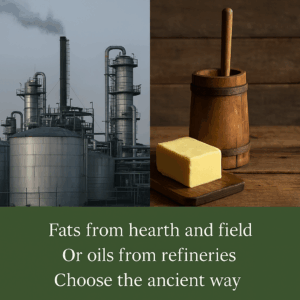For thousands of years, people pressed olives for oil, churned butter from milk, rendered fat from animals, or grated coconuts to make coconut oil. These are simple, mechanical processes anyone could replicate at home. The resulting fats are stable, whole, and deeply tied to human evolution.
The Fats Born in Industry
By contrast, seed oils like canola, soybean, corn, and sunflower didn’t exist in the human diet until the 20th century. You can’t just squeeze a soybean and get oil. Instead, seeds are crushed under high heat, bathed in petroleum-derived solvents like hexane, chemically bleached, and deodorized to mask rancid smells. These fragile oils are then bottled and marketed as “heart healthy.”
The Cholesterol Story
One reason seed oils rose to prominence is that they lower LDL cholesterol. That became the holy grail of health advice. But cholesterol is not a toxin: it’s a vital molecule. Nearly a quarter of all the cholesterol in your body is in your brain, where it coats nerves and helps you think, learn, and remember. Without cholesterol, brain cells literally can’t talk to each other.
This is why simply lowering cholesterol doesn’t guarantee health. In fact, drugs like statins, prescribed to slash cholesterol production, have been linked to memory loss and brain fog in some users; prompting FDA warnings. Symptoms usually reverse when the drug is stopped, underscoring a simple truth: cholesterol is essential, not evil.
Lowering LDL ≠ Lowering Risk
Research has shown that replacing saturated fats with seed oils lowers LDL on a blood test. But real-world outcomes are murkier. Some major trials (like the Minnesota Coronary Experiment) showed no reduction in heart attacks or death, despite lower cholesterol. In some cases, older adults with the lowest cholesterol actually had the highest risk of dying.
The Bigger Risk: Fragile Fats
Seed oils are rich in omega-6 polyunsaturated fats, which are chemically unstable. When processed or heated, they oxidize into toxic byproducts that can damage cells, fuel inflammation, and accelerate aging. These hidden costs aren’t captured by a simple LDL number.
The Way Forward
Instead of trading traditional fats for industrial oils, choose stable, whole-food fats:
• Butter, ghee, and cream from pastured animals
• Olive and avocado oil, pressed without chemicals
• Coconut oil or rendered animal fats for high-heat cooking
These are the fats humans co-evolved with; fats you could, in theory, make in your own kitchen or village. They are nourishing, stable, and time-tested.
Conclusion
Health isn’t about reducing one lab number at all costs. Cholesterol is the backbone of your brain and hormones. Industrial seed oils may lower LDL on paper, but they come with risks that whole, traditional fats do not. When it comes to nourishing the body and mind, the wisdom of our ancestors often points the way.
References
1. Ramsden CE, et al. Re-evaluation of the Minnesota Coronary Experiment. BMJ. 2016;353:i1246.
2. Aramburu N, et al. Effect of reducing saturated fat intake on cardiovascular outcomes. Front Public Health. 2024.
3. Hamley S. Replacing saturated fat with linoleic acid–rich oils and CHD outcomes. Adv Nutr. 2017.
4. U.S. FDA Drug Safety Communication. Statins and cognitive side effects. 2012.
5. Dietschy JM, Turley SD. The brain as a cholesterol-synthesizing organ. Curr Opin Lipidol. 2001.

